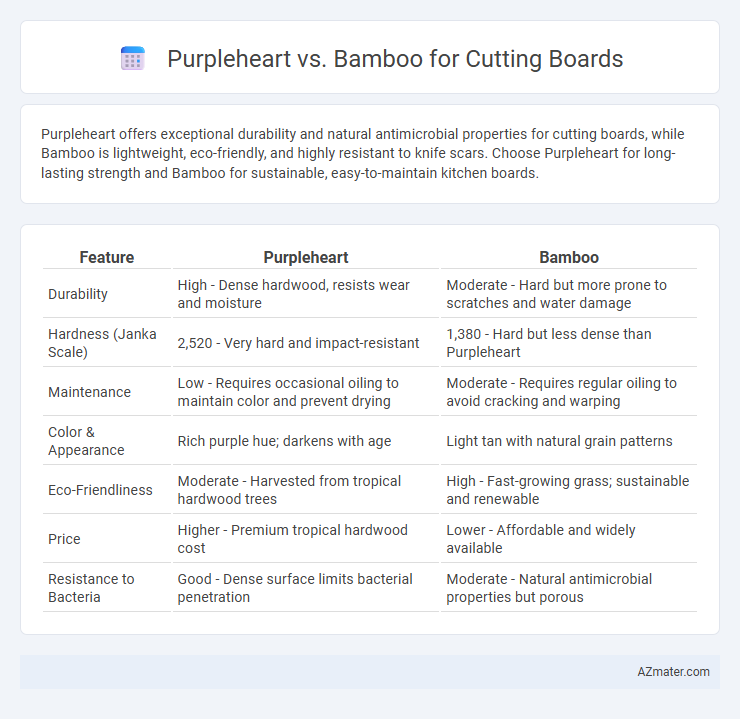Purpleheart offers exceptional durability and natural antimicrobial properties for cutting boards, while Bamboo is lightweight, eco-friendly, and highly resistant to knife scars. Choose Purpleheart for long-lasting strength and Bamboo for sustainable, easy-to-maintain kitchen boards.
Table of Comparison
| Feature | Purpleheart | Bamboo |
|---|---|---|
| Durability | High - Dense hardwood, resists wear and moisture | Moderate - Hard but more prone to scratches and water damage |
| Hardness (Janka Scale) | 2,520 - Very hard and impact-resistant | 1,380 - Hard but less dense than Purpleheart |
| Maintenance | Low - Requires occasional oiling to maintain color and prevent drying | Moderate - Requires regular oiling to avoid cracking and warping |
| Color & Appearance | Rich purple hue; darkens with age | Light tan with natural grain patterns |
| Eco-Friendliness | Moderate - Harvested from tropical hardwood trees | High - Fast-growing grass; sustainable and renewable |
| Price | Higher - Premium tropical hardwood cost | Lower - Affordable and widely available |
| Resistance to Bacteria | Good - Dense surface limits bacterial penetration | Moderate - Natural antimicrobial properties but porous |
Introduction to Purpleheart and Bamboo Cutting Boards
Purpleheart cutting boards are crafted from the dense, durable heartwood of the Peltogyne tree, known for its rich purple hue and natural resistance to moisture and bacteria, making it a long-lasting choice for kitchen use. Bamboo cutting boards, made from fast-growing, eco-friendly grass fibers, offer a lightweight, sustainable option that is naturally antimicrobial and less prone to warping compared to traditional hardwoods. Both materials provide distinct benefits, with Purpleheart emphasizing durability and unique aesthetics, while bamboo prioritizes environmental sustainability and ease of maintenance.
Material Origins and Sustainability
Purpleheart wood, sourced from the Peltogyne genus native to Central and South American rainforests, is prized for its durability and naturally vibrant purple hue. Bamboo, a fast-growing grass primarily cultivated in Asia, offers excellent sustainability due to its rapid renewability and minimal water requirements. Both materials provide eco-friendly options for cutting boards, but bamboo's quicker replenishment rate makes it a more sustainable choice compared to the slower-growing tropical hardwood purpleheart.
Durability and Hardness Comparison
Purpleheart offers exceptional durability and hardness, registering about 2200 on the Janka hardness scale, which makes it highly resistant to scratches and wear for cutting boards. Bamboo, while eco-friendly and sustainable, has a lower hardness rating of approximately 1350, making it more prone to denting and surface damage over time. The dense, tight grain structure of Purpleheart provides superior longevity and resistance to knife marks compared to the softer, more fibrous texture of Bamboo.
Knife Friendliness and Surface Wear
Purpleheart wood offers moderate knife friendliness with its dense and hard surface, which can cause slight blade dulling over time but provides excellent durability against surface wear. Bamboo, being a grass product with a harder, more brittle surface, tends to be less forgiving on knives, potentially leading to quicker blade dulling while showing good resistance to scratches and cuts. Both materials are durable, but purpleheart balances surface wear and knife friendliness more effectively, making it a preferred choice for longer-lasting cutting boards.
Maintenance and Cleaning Requirements
Purpleheart cutting boards require periodic oiling with mineral oil to maintain their vibrant color and prevent drying or cracking, while bamboo boards benefit from similar oiling but have a denser grain that resists moisture absorption better. Both woods need gentle hand washing with mild soap and water, avoiding prolonged soaking to prevent warping or splitting. Bamboo's natural antimicrobial properties make it easier to clean and maintain, whereas purpleheart may need more attentive care to avoid surface damage from harsh cleaning agents.
Aesthetic Appeal and Color Differences
Purpleheart cutting boards showcase a rich, vibrant purple hue that deepens over time, providing a unique and striking aesthetic appeal. Bamboo cutting boards offer a warm, natural golden-yellow tone with subtle grain patterns, creating a classic, minimalist look. The distinct color longevity and evolving intensity of Purpleheart contrast with bamboo's consistent, light shade, influencing kitchen decor choices significantly.
Antimicrobial Properties
Purpleheart wood exhibits moderate natural antimicrobial properties due to its dense grain and presence of natural compounds that inhibit bacterial growth, making it a reliable choice for cutting boards. Bamboo is renowned for its strong antimicrobial characteristics, as it contains natural silica and antimicrobial agents that reduce bacterial accumulation and resist odors effectively. While both materials offer hygienic benefits, bamboo's inherent antimicrobial properties often make it more suitable for maintaining a sanitary cutting surface.
Price and Market Availability
Purpleheart cutting boards are generally more expensive due to the wood's rarity and unique deep purple hue, making them a premium choice in the market. Bamboo cutting boards offer a budget-friendly alternative with widespread availability, benefiting from bamboo's fast growth and sustainability appeal. Market availability for bamboo is significantly higher, found in most kitchenware stores and online platforms, whereas Purpleheart products are often limited to specialty woodworkers or upscale retailers.
Environmental Impact and Eco-Friendliness
Purpleheart wood is a dense, durable hardwood harvested from sustainable forests in Central and South America, offering a long-lasting cutting board option that reduces the need for frequent replacements. Bamboo cutting boards come from rapidly renewable grass species, growing quickly without pesticides or fertilizers, making them highly eco-friendly and biodegradable. Both materials minimize environmental impact compared to plastic, but bamboo's swift regrowth and lower carbon footprint give it a distinct advantage in sustainability.
Verdict: Which is Better for Your Kitchen?
Purpleheart cutting boards offer exceptional hardness and rich purple hues that resist knife marks and bacterial growth, making them ideal for durability and aesthetics. Bamboo boards provide a more affordable, eco-friendly option with natural antimicrobial properties and lighter weight but tend to be softer and may require more maintenance. Choose Purpleheart for long-lasting, visually striking durability, or Bamboo for budget-friendly, sustainable kitchen use.

Infographic: Purpleheart vs Bamboo for Cutting Board
 azmater.com
azmater.com